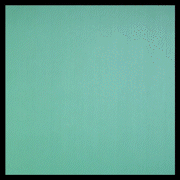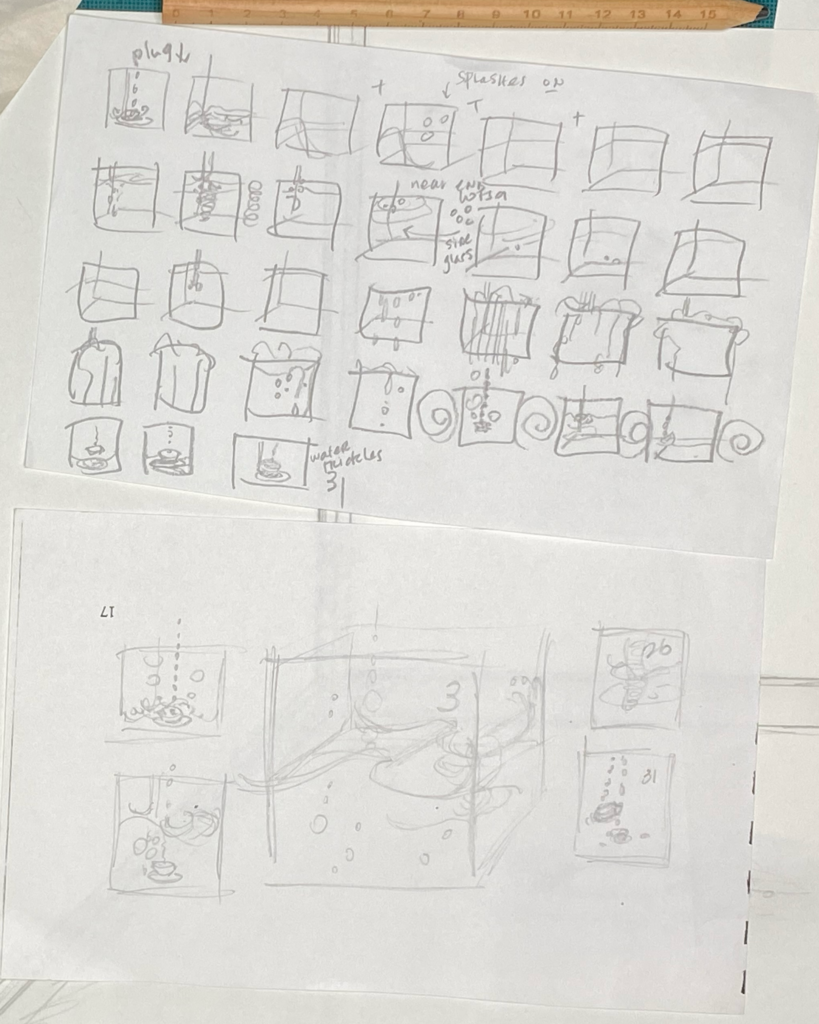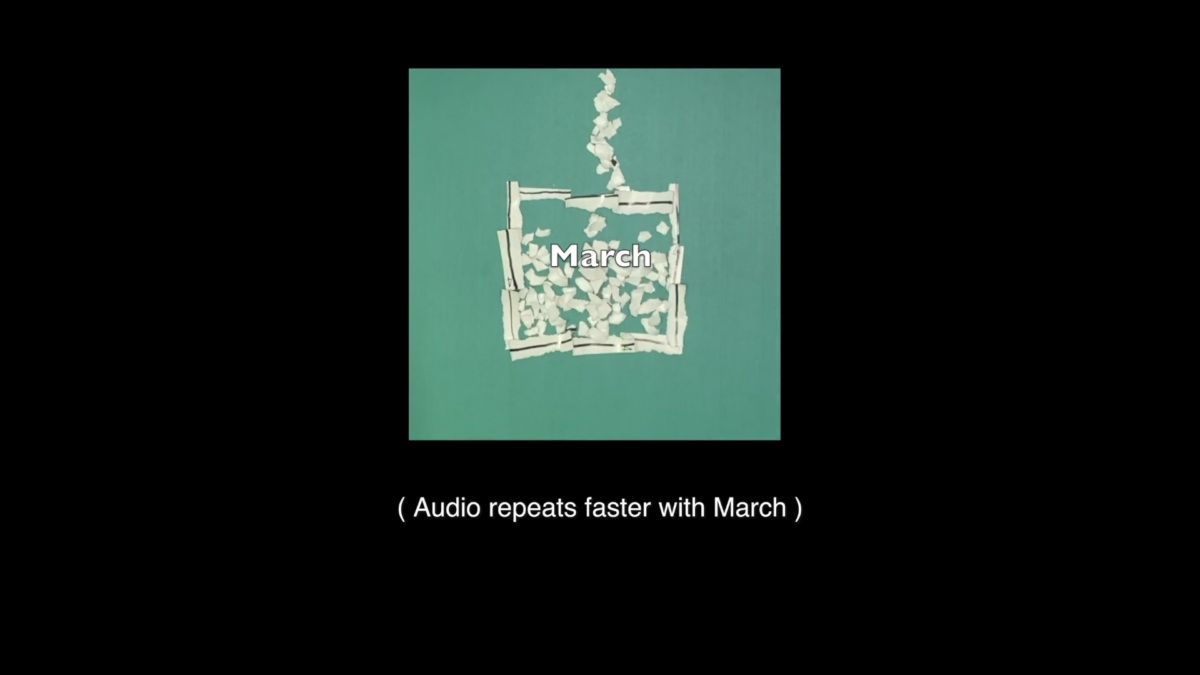Creator: Kay Slater
Exhibition: It’s a Date
Published: February 2022
Format: Short film and animated gif
Content Advisories: Video Essay contains content related to addiction, anxiety and mental illness. It is implied in the project but is not explicit.
a sōzu year, a short film.
a sōzu year meme, animated gif

Description of the Work
A sōzu year is a short video with English captions and visual descriptions contemplating calendars as a readymade and art making material. The video can be watched with or without sound and invites the viewer to consider experiencing the narrative with or without sound, sight, or any understanding of the materials used to create the animation. A sōzu year was created for the It’s A Date exhibition, running February 2022, with curator Jonathan Dawes and the Papercut Arcade collective.
There exists a YouTube video as well as a .gif with no sounds or captions. But ultimately, the piece is designed to be run on a continuous loop; therefore, it has also been uploaded to instagram where you can see it as such.
Artist Statement
Project Statement:
CW: addition, anxiety/mental illness
Printed calendars are meant to help organize days and weeks by adding and filling in the square spaces representing days, within rectangular weeks, within square months, within square pages. There is something, to me, that is too small and constraining about printed calendars, both the amount of space you have per day, and also the rigid grid. Growing up, I always felt frustrated with calendars as my handwriting is quite large and gestural and the small daily spaces didn’t allow for me to write enough detail – usually causing me to use something else and forget about my hanging calendars until months later. Rejecting the layout as not being a “fit” for me, I reduced the calendar to pieces and shapes which allowed me to better visualize what my months or days actually look like; a shifting net rather than a rigid square. I continue to explore the idea of “fitting” and “filling” in the animation narrative.
It is important to me to create projects with multiple points of entry. The captions/subtitles, transcripts, and visual descriptions are as necessary as any other visual, auditory, or conceptual element in my work. I wanted to approach this project using accessibility tools as a fluid part of my creative toolkit, rather than something that was added at the end to “accommodate” people. As the video plays and increases in speed, both the captions (whose best practices require 21 characters per second to be considered accessible) and the audio description (that usually runs quickly between content to catch up a non-visual viewer) run in time with the animation speed, becoming indiscernible and too quick to use or listen to as the months fly by. I wanted the anxiety and fatigue of planning, time management, and able-bodied time expectations to be translated across mediums.
My handwriting is not the only thing that causes me to struggle within the finite container of a printed calendar day. I am also a workaholic dealing with chronic anxiety. My days fill with overlapping meetings, stretching well beyond a “work day” and looking more like a to-do list, rather than a gentle reminder of a date’s importance. I am bothered by the calendar, as it acts like a mirror to my mania. It shows me that I, myself, am a barrier to wellness, refusing to schedule one thing at a time, neatly contained within a day and with white spaces around the edges itself implying time for breaks and rest. The thought of only scheduling one or two things in a day causes me some stress – ha! wait – no, actually, it goes deeper than that. It feels like a lie. I have tried taking breaks or leaving days open for rest, only to find that I will schedule and fill up a day that is empty. I have such a relationship with my digital calendar that it feels like it lays on top of my life. It tells me where to go, what I’m doing next, and what to get ready for – something a physically calendar can’t do and, if it could, it only would show the messy, dysfunctional and unbalanced way I move through a week.
Process:
I had so many ideas when this theme was announced.
I was thinking about doing daily thumbnails from the squares cut out from a month in mixed media. This would have been tightly connected to my ongoing practice in Octobers to create a mixed media work daily, but with the challenge of working extremely small. The gloss faded quickly from this idea as I struggled to fit any gesture that was satisfying into the tiny space. My second idea was to create an advent calendar, contemplating time, anticipation, and reward – but as I started my initial research around advent calendars, I was less interested in the history of German Lutherans and the practice of celebrating Christmas. My third idea was a sensory calendar, trying to decenter it as a visual experience. I did end up doing a lot of thinking about this and went searching for different kinds of calendars I could play with. There was an opportunity to talk about time as a colonial construct and how systems based on colonial time are oppressive and don’t allow for community consultation, Indigenous ways of learning and living, and is ultimately a tool for capitalism. There were so many ideas. I needed to get a calendar so I could start to play and imagine.
( laughs ) But I never use printed calendars. I was gifted one in the past few years, but I don’t think I opened it and may have used the paper for another project as soon as the year was over. Before that, it was the same – always gifted, never bought. I received a calendar for use from our curator and collective member Jon who had a few to spare.
A gifted calendar to me is a little like buying someone a jar of horseradish. It will keep for the full year, even if you don’t open it, and as a garnish, you can choose how and how much you use it. Someone can gift it if it’s unopened and there is time still left before it expires, but as soon as you open it and write in it or to keep the metaphor going, take a scoop out of it, you’re stuck with it until the year is up.
Ideas around gifting, receiving items that don’t really work or fit for you, my huge handwriting, the discomfort around containing that which can barely be contained – these ideas stuck with me through the month and was what I ultimately followed to produce a sōzu year. Ripping up the pieces of the calendar into smaller pieces, no longer able to hold any writing or text, was the most satisfying thing I did to my calendar and ultimately decided how I would use the material in my piece.
Curator’s question:
I had to look up sōzu before I connected it to a type of Japanese water fountain that I had seen before. Can you explain the significance of the title of your piece?
My piece is about filling up, emptying, and then repeating it all over again. The metaphor is pretty in your face when you consider the similarities between the actions of a sōzu and my looping animation. While they are not designed to speed up or slow down, the speed at which the water flows through the fountain can affect the pivot of the bamboo. Without water, the fountain does not run, and when a calendar is not used, it is just paper hanging on a wall.
I see both as a kind of metronome. The calendar portions out potential available time, vast and open. It tries to contain the possibilities of the future before it happens, and does so by chopping it into equal portions, days like quarter notes, weeks – a phrase of many moving moments, and months, like a piece of sheet music, with staves and a double bar line ending the piece 28, 30, or 31 bars later. A new song begins once you turn the page. The sōzu will fill and empty within a minute or so, repeating its cycle as long as water flows, marking each rotation with a loud clack.
A sōzu is a Shishi-odoshi, which loosely translates to scare deer or scare boar. It’s a device originally intended to frighten away animals, similar to a scarecrow which in Japanese is referred to as a Kakashi. Sōzu, the word, has become interchangable with shishi-odoshi, even as its function within a Japanese garden is usually described (in English) as a way to break up the silence or add audible texture to the garden. I also liked how both a calendar and simple fountain have remained in used during these modern, tech-heavy times. In contemplating them both, I wonder which will survive, if one will outlive another.
I named this project using a Japanese word that has been borrowed for English to refer to these fountains. They are sold in North American gardening and landscape shops and have made their way into many backyard gardens I visited growing up. However, I also acknowledge that English, and the western world are quick to take, and appropriate whenever it suits them, and as a white colonist, having grown up and thrived on stolen land, it’s important that I title my piece and present my piece respectfully, naming that I am not Japanese, nor do I speak the language. My understanding of the sōzu and Japanese gardens is shallow and if I was ever to show this work outside of the collective, more research would be necessary.
Process Photos

I also produced a small podcast for the exhibition on readymades. This can be listened to or read here:
